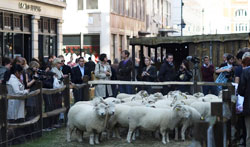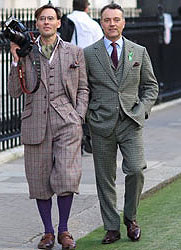|
FLOCK OF PEOPLE TO SEE SAVILE ROW SHEEP
Customers visiting Savile Row for the first time one sunny day in October were undoubtedly taken aback to find the Row had its very own flock of sheep peacefully grazing down its length.
 These complacent, rotund specimens, suitably immaculate for the setting, had in fact been herded in at crack of dawn for a special promotion of wool. These complacent, rotund specimens, suitably immaculate for the setting, had in fact been herded in at crack of dawn for a special promotion of wool.
And what a throng they drew. Not only crowds of delighted onlookers, unused to seeing herbivores in Mayfair, but an international press pack and assorted photographers, plus a hovering helicopter filming a birds eye view.
The event, under the patronage of the Prince of Wales, is part of a five year  campaign to sing wool’s praises, the fibre campaign to sing wool’s praises, the fibre  for the modern, natural-minded marketplace. for the modern, natural-minded marketplace.
Man-made fibres may no longer hold the sway they once did but are still a force to be reckoned with. And younger generations, who don’t know where their lamb chop or meat burger may have come from, are even less likely to appreciate the virtues of a wool sweater or worsted suit, let alone its provenance in the wool hierarchy.
So the Campaign for Wool, under the auspices of the Woolmark Company, Savile Row Bespoke, cloth mill Fox Bros,  cloth cloth  merchants Dormeuil, and R. Gledhill, woollen yarn spinners, is underway to re-educate the public into the benefits of wearing wool. merchants Dormeuil, and R. Gledhill, woollen yarn spinners, is underway to re-educate the public into the benefits of wearing wool.
These include its Safety, for a start. Safety? Well, wool is naturally flame retardent, has a higher ignition threshold than many other fibres and gives high UV protection.
It is breathable, durable, elastic, and multi-climatic – cool when it is warm and warm when its cool. It is bio-degradable, so won’t clog up the landfill sites. And,  with modern methods, is easy care, able to be with modern methods, is easy care, able to be  machine washed and tossed in the tumble drier – not your Savile Row suit, of course. machine washed and tossed in the tumble drier – not your Savile Row suit, of course.
And most importantly in today’s climate, it is a natural fibre, from animals out in the open, and sustainable, with each sheep producing a new fleece each year.
Prince Charles naturally approves of these virtues. The tailoring fraternity do too, which is why the campaign got underway in this royal centre of the bespoke craft. The tailors prefer to work with wool cloth, not just because it le nds itself to nds itself to  tailoring so well but also because it keeps its shape, lasts longer, and has more ‘guts’ than other fibres. tailoring so well but also because it keeps its shape, lasts longer, and has more ‘guts’ than other fibres.
The sheep lending their glamour to the proceeding were Exmoor Horns and Bowmonts. To those readers unfamiliar with the various types, the former is a typical hill breed from the high ground of Exmoor National Park, with a fleece that lends itself well to West of England tweeds; the latter is a new-ish breed, the result of bringing the Saxon Merino and Shetland together, to form this cross that is the UK’s answer to Australia’s Merino.
Merino is the fleece that goes into making fine worsteds, and most of it is imported from Australia. British wool in general is of a sturdier composition, and more suited to tweeds and heavy coatings. But this new breed, which gives a superfine fleece variety (with a count of just 15-20  microns for the purists) could start to change that. microns for the purists) could start to change that.
Top, sheep-gazing in the Row. From left to right above - John Hitchcock of Anderson & Sheppard and Charlie Allen ; Paul Abrahams, Huntsman, and Geoff Wheeler, Dugdale Bros; Brian Lewis, Meyer & Mortimer, and Mark Powell; Steven Hitchcock, and Patrick Murphy of Huntsman. Right, photographer Guy Hills and Douglas Cordeaux, Fox Bros. Below, John Thorley, chairman Campaign for Wool.
It seems incredible now that so much wool from British sheep is in fact destroyed or thrown away, the price at market not warranting the expense of shearing and transporting. Britain’s wealth was founded on her golden fleece. How did it come to this?
The British Wool Marketing Board, established in 1950 to get the best returns for farmers, has dismissed British wool as too coarse for clothing and seems sanguine about the fact that so much fleece is wasted. Given that all fleece must pass through its processing to be sold, its monopoly grip on the industry perhaps has much to answer for.
 But the famous old mill of Fox Bros in the West Country has vowed to use more home grown wool in its cloths, and is already offering some attractive, lighter, softer tweeds using fleece from British flocks. But the famous old mill of Fox Bros in the West Country has vowed to use more home grown wool in its cloths, and is already offering some attractive, lighter, softer tweeds using fleece from British flocks.
With more textile and clothing companies apppreciating the benefits of wool, it seems inevitable that British famers may actually have a market for their fleece once more. The happy day in Savile Row is but the start of a campaign to see this natural fibre regain its deserved appreciation.
|